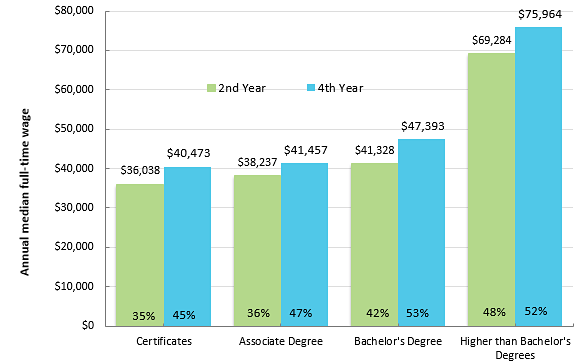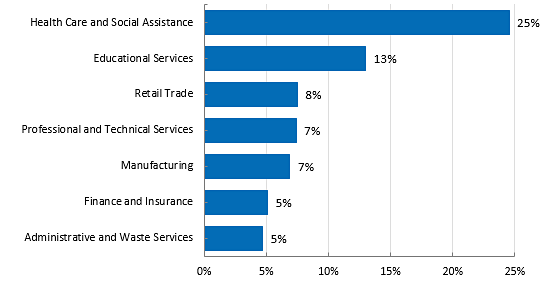College Graduate Outcomes
Tracking college graduate employment and wage outcomes has gained national and state importance in light of increasing costs of obtaining a postsecondary education coupled with the student debt burden taken on by a large number of college graduates.
The Minnesota Graduate Employment Outcomes tool shows the employment outcomes of recent Minnesota postsecondary graduates. Matching graduate data from the Minnesota Office of Higher Education with wage data from the Minnesota Department of Employment and Economic Development enabled the development of this web-based searchable tool.
The public can search economic outcomes of Minnesota graduates working in the state. The tool does, however, have some limitations and should be used with caution.
Annual Median Wage of Minnesota College Graduates Increases with Each Level of Education
Class of 2010 graduates employed full-time, year-round in Minnesota during 2nd and 4th year after graduation.

Percent of 72,759 graduates working full-time, year-round after graduation shown at bottom of each bar.
Source: Minnesota Office of Higher Education and Minnesota Department of Employment and Economic Development
See wages for all award types by program of study four years after graduation
Employment Highlights for Minnesota College Graduates
- 72 percent of all graduates were employed in Minnesota at any time (worked in any one of the four quarters) during the second year after graduation.
- Overall, graduates working full-time from the second year to fourth year after graduation earned more than those with lower levels of education. This was true with each increase in level of award (certificate, associate degree, bachelor's degree or graduate degree).
- Annual median wage was $43,867 for recent employed graduates working full-time, year-round statewide during the second year after graduation. Wages increased to $48,111 in the fourth year.
- Annual median wages were higher for graduates working in the Twin Cities than those working in Greater Minnesota.
- The program of study or major, along with the level of award earned, showed the greatest effect on wages earned by graduates.
- Graduates who majored in engineering and engineering technologies, health science and computer sciences earned the most at every level of award. These are the same occupations that are high-wage, high-demand occupations in Minnesota and in the nation.
- Health care and social assistance industry employs the highest percentage of graduates.
69 Percent of Graduates were Employed in Top 7 Industries

192,263 class of 2010, 2011, 2012 and 2013 graduates employed 24 months after graduation.
Source: Minnesota Office of Higher Education and Minnesota Department of Employment and Economic Development
What is Available to Search in the Graduate Employment Outcomes Tool
- Employment outcomes of recent Minnesota college graduating classes working in Minnesota
- Hourly wages of graduates either 12, 24 or 48 months after graduation
- Annual wages of full-time, year-round graduates between second and fourth year after graduation
- Type of Minnesota postsecondary institution conferring award
- Wages for Minnesota statewide, Twin Cities region or Greater Minnesota
- Level of award received, either certificates below bachelor's degree, associate degree, bachelor's degree and awards earned above bachelor's degree
- Program and major of graduates at the 2-digit and 4-digit CIP level
- Top industries where college graduates found employment after graduation
Please Note:
- Accessing the Microsoft Excel file(s) on this page may require you to
download the free Excel Viewer from Microsoft
Related Information in Minnesota Measures
Related Links
- Where Are the Jobs for Recent Minnesota Graduates?
- Minnesota Department of Employment and Economic Development - Graduate Employment Outcomes
- Minnesota Department of Employment and Economic Development - Career Profile
- Measuring Employment Outcomes for Graduates
- Minnesota's STEM Workforce
- Georgetown Center for Education and the Workforce Reports
- Georgetown Center for Education and the Workforce - Healthcare
- Georgetown Center for Education and the Workforce - Certificates: Gateway to Gainful Employment and College Degrees
Quick Links
- Why College?
- Explore Your Interests & Careers
- Prepare at School
- Summer Academic Enrichment Program
- Earn College Credit in High School
- Recommended High School Classes & Graduation Requirements
- Advice for Students with Disabilities
- Succeed as an Adult Student
- Useful College Prep Resources
- Minnesota Goes to College!
- Get Ready Program Overview
- College Planning Presentation Information
- College Navigator Presentation Request Form
- Minnesota Indian Scholarship Program Outreach
- Competitive Grant Programs
- Dual Training Grant
- Public Engagement Calls
- "Life After Now" Podcast
- Certified Nursing Assistant Training
- Direct Admissions Minnesota
- Collecting Data from Minnesota Postsecondary Institutions
- Campus Financial Aid Administrator Resources
- Statewide Financial Aid Conference
- Campus Student Enrollment Reporting Resources
- Ordering Materials for Your Students
- Supplementing Your College Counseling
- Early Awareness Efforts
- Student Homelessness in Higher Education Resources
- Shared Library Resources
- MN FAFSA Tracker
- Campus Sexual Violence Prevention and Response
- Statewide FAFSA Filing Goal
- Financial Aid Estimator
- Online Applications
- About Financial Aid
- What Does College Cost?
- Tips for Lowering the Cost of Higher Education
- Institutional Payments
- Financial Aid You Don't Repay
- Financial Aid You Must Repay (Student Loans)
- Financial Aid You Earn
- Military Service Education Benefits
- Reduced Out-of-State Tuition Options
- Education Tax Benefits
- New Video Demystifies Paying for College
- Public Service Loan Forgiveness
- Useful Online Resources
- Ready, Set, FAFSA!
- Data Maps and Infographics
- Educational Attainment Goal 2025
- Minnesota Measures
- Minnesota P-20 Statewide Longitudinal Education Data System
- College Readiness & Participation Data
- Student Enrollment Data
- Degrees, Graduation Rates, Attainment & Outcomes
- Financial Aid Data & Trends
- Tuition & Fees Data
- Student Health and Safety
- Institution and Data Search
- Transfer Students
- Research Reports
- A-Z Data Table Index




